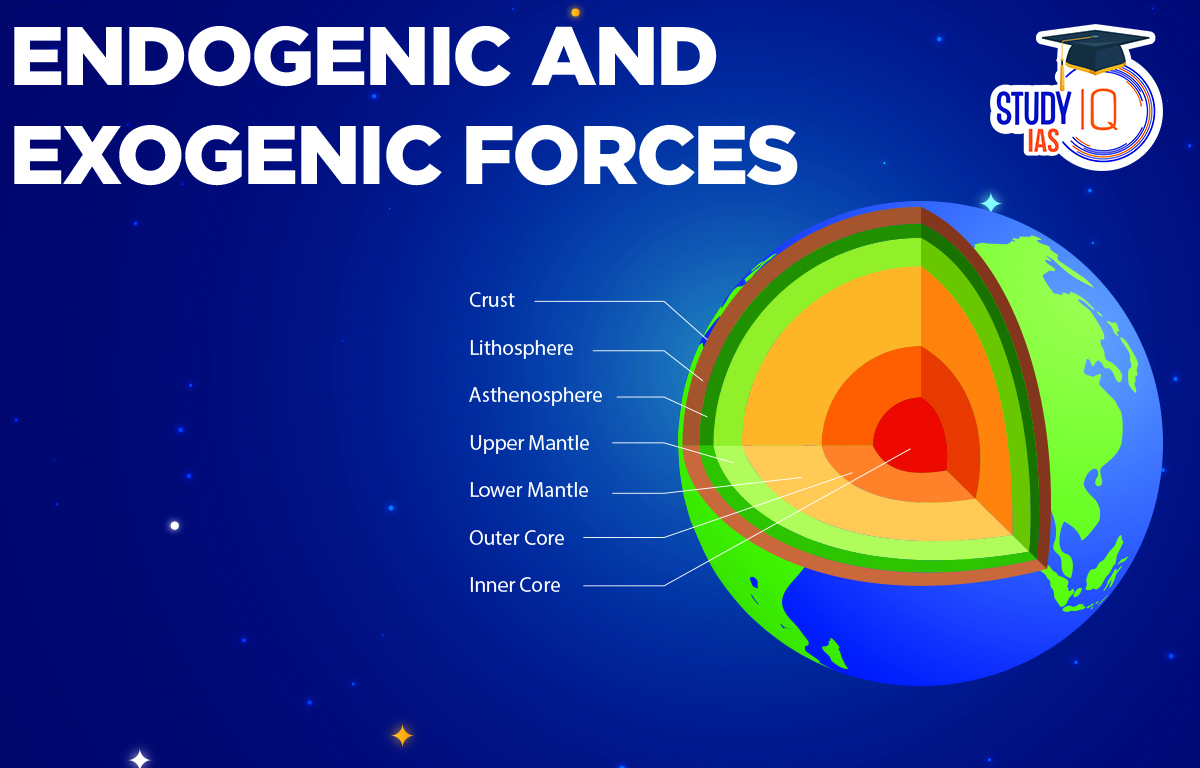Table of Contents
Endogenic and Exogenic Forces
The term “geomorphic processes” refers to the processes that cause changes to the surface of the earth. Exogenic and Endogenic Forces are the two categories into which these processes fall. Exogenic forces, or external forces, come from the earth’s surface or the atmosphere. On the other hand, endogenic forces, also called internal forces, come from pressure within the ground.
Exogenic Forces Meaning
Exogenic forces, or external forces, come from the earth’s atmosphere or from outside the planet. Exogenic factors are forces that provide energy for activities happening at or near the earth’s surface. These factors are mostly driven by gravity or forces from the atmosphere.
The tension from exogenic forces on the earth’s surface causes changes in the land. Examples of these forces include erosion, oxidation, mass wasting, and weathering. Exogenic processes are events that happen on or above the earth’s surface. They include things like comet and meteoroid impacts, the moon’s tidal effects, and solar radiation.
Endogenic Forces Meaning
Endogenic forces can be divided into two types: sudden changes and very slow changes. Slow changes happen gradually and might not be noticeable during a person’s lifetime. For example, the formation of mountains and the occurrence of earthquakes are both caused by these internal forces.
There are two main types of processes caused by these forces:
- Orogenic processes: These create mountains through a lot of bending and folding of the Earth’s crust.
- Epeirogenic processes: These involve larger sections of the Earth’s crust lifting or bending.
Endogenic forces are important because they help shape the Earth’s surface. They come from the heat inside the Earth, natural radioactivity, and the movement of the Earth itself.
Difference between Exogenic and Endogenic Forces
| Endogenic Forces | Exogenic Forces |
| These are internal forces that are present in the Earth’s interior. | These are the external forces that are active on the earths surface |
| “constructive forces.”beacause they have build up land | “destructive forces.” Because they wear down the land |
| The heat generated by the interior of the earth is the primary energy source for forces that propel endogenic movements. | The principal exogenic processes include wasting, erosion, deposition, and weathering. |
| The different layers of the ground have varying temperatures and pressures, which leads to differences in density. These density differences happen because of changes in temperature and pressure as you go deeper into the Earth. | Changes from high to low levels, like from high pressure to low pressure, cause all the movements on the Earth’s surface and inside the planet. |
| Endogenic movements are caused by the movement of the lithospheric plates (crust and upper mantle), which are driven by convection currents in the mantle. | The atmosphere, which is influenced by the sun’s primary energy as well as the gradient that tectonic forces create, provides the exogenic forces with their energy. Tectonic forces or earth movements caused by endogenic forces are primarily responsible for the slopes on the earth’s surface. |
| You only notice the effects of endogenic forces when they cause sudden damage, like during an earthquake. | Over hundreds or millions of years, exogenic forces create changes that we can see. |
| Earthquakes and volcanic eruptions are two examples. | Examples include winds, rivers, and glaciers |
Types of Endogenic Forces
Slow Movements (Diastrophic forces)
The movement of the solid components that make up the earth’s crust can produce forces known as catastrophic forces. The term “disaster” refers to any process that alters, raises, or constructs a piece of the earth’s crust. Diastrophism includes:
Orogenic Processes
In plate tectonics, orogenic processes create mountains and work along the Earth’s surface. A good example is the Himalayas.
There are two types of forces:
- Tension: This pulls apart and causes cracks, like in the Sierra Nevada mountains.
- Compression: This pushes together and forms folds, as seen in the Himalayas.
Epeirogenic Processes
Epeirogenic movements are processes that create continents. They move along the Earth’s radius and are often called radial movements. These movements can go in two ways: they can either lift up or sink down.
They create changes in the land with gentle waves and little folding. A well-known example is the area between the Limpopo and Zambezi rivers in southern Africa.
Epeirogenic movements can be split into upward and downward movements. Downward movement causes land to sink, called subsidence. Upward movement lifts land, creating features like raised beaches and terraces.
Sudden Movements
Sudden land movements happen at the edges of lithospheric plates. These edges are unstable because of the pressure from the magma in the mantle pushing and pulling. Two major examples of these quick changes are earthquakes and volcanoes, which can change an area in a short time.
Types of Exogenic Forces
Weathering
Weathering can happen in two ways:
- Physically: Rocks break down due to pressure changes, wear from wind or water, and the actions of plants and animals.
- Chemically: Rocks can be broken down by water, carbon dioxide, living things, and acid rain.
Erosion
Natural forces like the wind, water, ice, and gravity transport the clay materials away. Weathering is the first stage of erosion.
- Surface water that is moving: This type of landscape is referred to as river terrain.
- Wind – These terrains develop in arid and dry regions where wind’s influence are predominant. These landscapes are known as aeolian.
- Glaciers – Alpine glaciers carved out these landscapes.
- Waves – Waves at the margins of the continent act to create them.
- Karst: Groundwater in karst or limestone regions creates these terrains..
Mass Movements
Mass movement also called slope movement or mass wasting, happens when materials on a slope gradually or quickly move down. This can include creeping, flowing, sliding, or falling. Gravity pulls on the bedrock and also affects the materials that have weathered.
Mass movement is not necessary for weathering to happen, but it does help. Unlike erosion, which is affected by things like waves and wind, mass wasting is only caused by gravity. It can be triggered by steep slopes, floods, earthquakes, and cutting down plants.
Erosion with Deposition
Erosion is the process of collecting and moving small pieces of rock by forces like flowing water, wind, and waves. While weathering helps erosion happen, it is not necessary for erosion to occur, erosion can still happen even if the rocks are not weathered.
As erosion takes place, the materials that are being moved settle down(Deposition) when the forces lose speed and energy, especially on gentle slopes.
Other Indian Geography Topics
Other Fundamental Geography Topics


 Desert Climate, Distribution, Climatic C...
Desert Climate, Distribution, Climatic C...
 Deserts of India Map, Features of Thar D...
Deserts of India Map, Features of Thar D...
 Indus Valley Civilization, History, Phas...
Indus Valley Civilization, History, Phas...





















